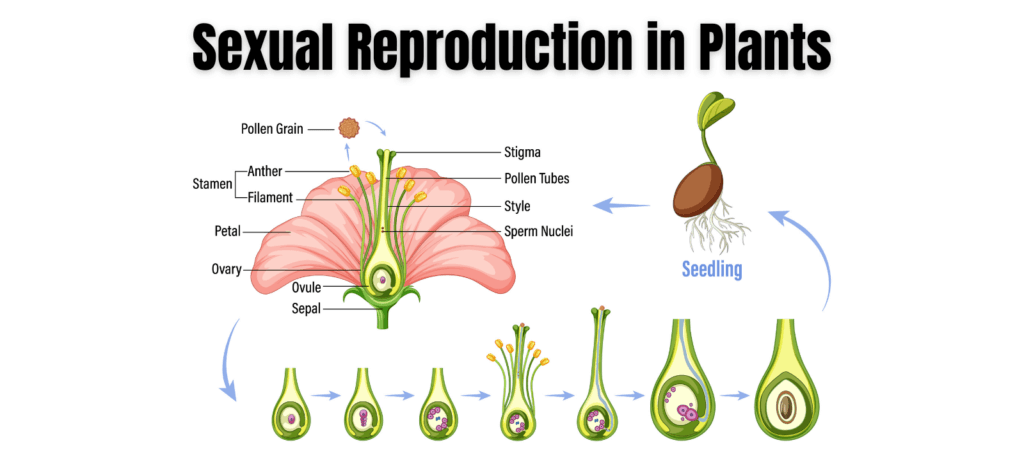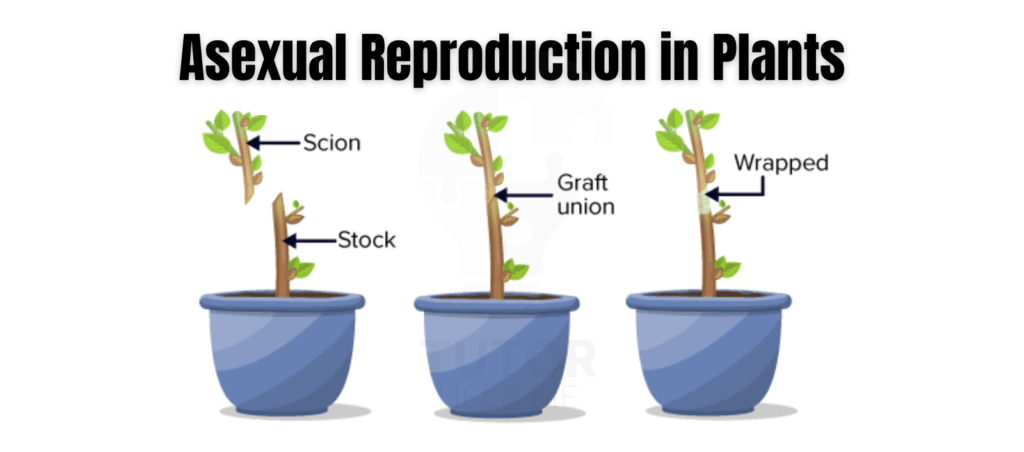Plant reproduction is the process by which plants create new plants to ensure the survival of their species. It occurs through sexual reproduction and asexual reproduction, each with unique advantages.
Why Do Plants Reproduce?
Plants reproduce to maintain their populations, spread to new areas, and adapt to changing environments. Reproduction in plants allows species to thrive by ensuring genetic diversity or rapid multiplication, depending on the method used.
How Do Sexual and Asexual Reproduction Differ?
Plants can reproduce in two main ways:
- Sexual reproduction in plants involves the combination of male and female gametes to create offspring with genetic variation. This occurs in flowering plants through pollination and fertilization.
- Asexual reproduction in plants creates offspring that are genetically identical to the parent plant. It requires only one parent and happens through vegetative propagation, such as bulbs or runners.
Sexual Reproduction in Plants
Sexual reproduction in flowering plants requires male and female parts to produce seeds. This process allows for genetic material from two parents to combine, leading to greater diversity in plant species.
How Do Flowers Help in Plant Reproduction?
Flowers play a key role in sexual reproduction. They contain the male part (stamen) and the female part (carpel), which help produce and transfer pollen grain to enable fertilization. Some flowers are adapted to attract pollinators using nectar, bright petals, and scent.
What Are the Male and Female Parts of a Flower?
A flowering plant contains:
- Male reproductive structures:
- Stamen – Consists of the anther (where pollen is produced) and the filament.
- Male gametes – Found inside pollen grains.
- Female reproductive structures:
- Carpel (pistil) – Includes the stigma, style, and ovary.
- Female gametes – Located inside the ovule within the ovary.
How Does Pollination Work?
Pollination is the process of pollen being transferred from the anther to the stigma of a flower. This can happen in two ways:
- Self-pollination – Pollen from one plant lands on the stigma of the same flower or another flower on the same plant.
- Cross-pollination – Pollen from one plant is transferred to a different plant, increasing genetic diversity.
Some wind-pollinated plants rely on air movement, while others depend on pollinators like bees and butterflies.
What Happens After Fertilization in Plants?
Once pollen reaches the stigma, it grows a pollen tube down to the ovary, allowing male gametes to reach and fertilize the female gametes inside the ovule. This process is called fertilization.
After fertilization, the ovule develops into a seed, and the ovary matures into a fruit, which helps in seed dispersal.

Asexual Reproduction in Plants
Asexual reproduction in plants is a process where a new plant grows without the need for male and female gametes.
This method allows plants to reproduce quickly and efficiently, producing offspring that are genetically identical to the parent plant.
Unlike sexual reproduction, which requires pollination and fertilization, this form of reproduction involves only one parent and does not rely on seeds.
How Do Plants Reproduce Without Seeds?
Many plants reproduce asexually using specialized structures. Instead of seeds, they develop new individuals from stems, roots, or leaves.
This process ensures that the genetic material remains unchanged, allowing plants to maintain successful traits.
Asexual reproduction only requires a single parent, making it an efficient way for plants to spread.
Vegetative Propagation: A Natural Method
One of the most common ways in which plants reproduce without seeds is through vegetative propagation. This process involves parts of the plant—such as roots, stems, or leaves—developing into new plants.
Several plant species rely on this method to grow and expand in their environment.
What Are the Different Methods of Asexual Reproduction?
1. Runners
Some plants reproduce asexually using runners, which are long, horizontal stems that grow above the ground.
These stems, also known as stolons, develop small roots and leaves at various points, eventually forming new plants.
Strawberries and spider plants are examples of plants that grow through runners.
2. Tubers
A tuber is an underground storage structure that contains nutrients to support the growth of a new plant.
Potatoes are a common example of this form of asexual reproduction. Small buds, or “eyes,” found on a potato can sprout and grow into a new plant under the right conditions.
3. Bulbs
A bulb is a round, underground structure that contains a complete plant inside. It consists of layers of modified leaves that store food, allowing the plant to survive unfavorable conditions.
When conditions improve, the bulb develops into a flowering plant. Examples include onions, tulips, and crocuses, which reproduce asexually using this method.
4. Cuttings
Cuttings involve taking a piece of a parent plant, such as a stem or leaf, and allowing it to grow into a new plant.
Gardeners often use this technique to produce genetically identical plants quickly.
Many trees and flowering plants can grow from cuttings, making it a widely used method in horticulture.
Why Is Asexual Reproduction Faster Than Sexual Reproduction?
Asexual reproduction is faster than sexual reproduction because it does not require pollination and fertilization.
Since there is no need for male and female gametes to combine, the process takes less time.
Additionally, a new plant can develop directly from the parent plant, ensuring continuous growth.
Key Advantages of Asexual Reproduction:
- Produces genetically identical plants, ensuring successful traits are maintained.
- Allows plants to grow in large numbers without the need for seeds.
- Helps plants spread quickly and survive in stable environments.
- Ensures plants can reproduce even when pollinators are absent.
Examples of Asexual Reproduction in Plants
Some plants also reproduce asexually alongside sexual reproduction. Many trees, native plants, and species of plants use both methods to adapt to different conditions.
For example, crocuses reproduce using bulbs, while many plants in the wild grow through vegetative propagation.

Key Differences Between Sexual and Asexual Reproduction
Plants reproduce using sexual reproduction or asexual reproduction. The table highlights the key differences:
| Feature | Sexual Reproduction | Asexual Reproduction |
|---|---|---|
| Number of Parents | Requires male and female gametes | Requires one parent |
| Genetic Variation | Offspring show genetic diversity | Offspring are genetically identical to the parent plant |
| Reproductive Structures | Involves pollination and fertilization | Uses vegetative propagation methods |
| Seed Formation | Produces seeds through fertilization | No seeds; new plants grow from roots, stems, or leaves |
| Speed of Reproduction | Slower process due to seed formation | Faster process, allowing rapid plant growth |
| Environmental Adaptation | Plants evolve through genetic material mixing | Plants maintain successful traits without change |
| Dependency on Pollinators | Some flowering plants rely on pollinators | No need for pollination or external agents |
Advantages and Disadvantages of Sexual Reproduction
Advantages of Sexual Reproduction
- Genetic diversity – Offspring inherit traits from male and female gametes, helping plants adapt to environmental changes.
- Stronger survival chances – Variations allow plants to evolve and resist diseases.
- Wider dispersal – Seeds travel away from the parent plant, reducing competition.
Disadvantages of Sexual Reproduction
- Slower reproduction – Seeds take time to develop and germinate into new plants.
- Dependency on pollinators – Many flowering plants rely on pollinators like bees and butterflies for pollination.
- Environmental limitations – Conditions such as extreme weather can prevent fertilization.
Advantages and Disadvantages of Asexual Reproduction
Advantages of Asexual Reproduction
- Faster reproduction – Plants reproduce asexually without needing seeds, allowing new plants to grow quickly.
- No pollinators required – Unlike sexual reproduction in plants, this method works without pollination.
- Preserves successful traits – The offspring remain identical to the parent plant, ensuring strong survival traits.
- Efficient for plant propagation – Gardeners and farmers use cuttings, bulbs, and tubers to produce new plants efficiently.
Disadvantages of Asexual Reproduction
- No genetic variation – Since plants are genetically identical, they are vulnerable to diseases.
- Overcrowding – Many plants that grow through vegetative propagation compete for space and nutrients.
- Lack of adaptability – Without genetic diversity, these plants struggle to survive environmental changes.
Why Do Some Plants Use Both Reproduction Methods?
Some species of plant use both sexual and asexual reproduction to maximize their survival chances. These plants can produce seeds through sexual reproduction while also growing vegetatively.
Examples of Plants That Use Both Methods
- Strawberries – Grow through runners (asexual) but also produce seeds (sexual).
- Crocuses reproduce using bulbs while also forming seeds through fertilization.
- Many trees can reproduce sexually but also grow from cuttings.
Using both reproduction methods allows plants to balance genetic diversity with rapid reproduction.
How Does Plant Reproduction Support Ecosystems?
Plant reproduction plays a vital role in maintaining ecosystems. Through sexual reproduction, flowering plants transfer pollen from one plant to another using pollinators like bees and butterflies.
This process, called pollination, helps sustain biodiversity by ensuring that different plant species thrive.
Plants that reproduce asexually grow without the need for male and female gametes. This method allows rapid growth, especially in areas where conditions make fertilization difficult.
For example, bulbs like tulips and vegetative propagation in strawberries create genetically identical plants. These methods provide food and shelter for various animals, supporting the balance of nature.
Why Is Plant Reproduction Important for Farmers?
For farmers, plant reproduction determines crop yield and quality. Sexual reproduction in flowering plants improves genetic diversity, which helps crops resist diseases and adapt to environmental changes.
Crops like wheat and maize rely on pollination and fertilization to produce seeds for the next harvest.
On the other hand, asexual reproduction allows farmers to grow identical to the parent plant varieties with desirable traits.
Techniques like cloning and vegetative propagation ensure that one parent plant can produce multiple offspring without genetic changes.
Farmers use this approach for crops like potatoes and bananas to maintain consistent quality.
Additionally, wind-pollinated plants like corn depend on natural forces to transfer pollen grain between flowers.
This type of reproduction ensures large-scale food production, benefiting the global food supply.
How Do Humans Use Plant Reproduction Techniques?
Humans have developed methods to control and improve reproduction in plants for better yield and quality. Some of these techniques include:
1. Grafting
Grafting allows farmers to join two different plants, combining the strengths of each. This technique is widely used in fruit trees like apples and grapes, ensuring stronger growth and better fruit production.
2. Cloning
In asexual reproduction, plants can also reproduce through cloning. This method produces genetically identical copies of a parent plant, ensuring consistent traits. Orchids and roses are commonly propagated this way to maintain flower color and fragrance.
3. Selective Breeding
This technique involves reproducing sexually selected plants with desirable traits. By controlling pollination, farmers can develop crops that are more resistant to pests and climate conditions.
4. Tissue Culture
Tissue culture allows scientists to grow new plants from small tissue samples. This process helps conserve native plants that may be endangered and ensures large-scale production of crops with high commercial value.
By using these methods, humans can enhance types of plants that are best suited for different environments, ensuring sustainable agricultural practices.
FAQ’s
Why Is Plant Reproduction Essential for Survival?
Plant reproduction ensures the survival of many plants by creating new generations. Without it, plant life would decline, leading to food shortages and habitat loss for living organisms like animals and insects.
Sexual reproduction in plants promotes genetic variation, which strengthens plant populations. Meanwhile, asexual reproduction allows plants to spread quickly, especially in challenging environments. Both methods play a crucial role in maintaining ecological balance.
How Do Reproduction Methods Affect Plant Diversity?
The types of reproduction in plants determine their ability to adapt and survive. Sexual reproduction involves mixing genetic material from two parents, creating unique offspring. This process helps species of plant evolve over time.
In contrast, asexual reproduction only requires one parent, producing identical to the parent clones. While this method is fast and efficient, it limits genetic diversity, making plants more vulnerable to environmental changes.
What Are Some Real-Life Examples of Plant Reproduction?
- Pollination and Fertilization: Apple trees rely on bees for pollen transfer, leading to fruit development.
- Vegetative Propagation: Plants like potatoes grow from underground stems, producing new shoots.
- Wind-Pollinated Plants: Dandelions use wind to spread seeds far from the parent plant, ensuring species survival.
- Germination: Sunflower seeds undergo germination, developing into mature plants that attract pollinators with nectar.
Read More Top Study Tips for Biology GCSE Students

